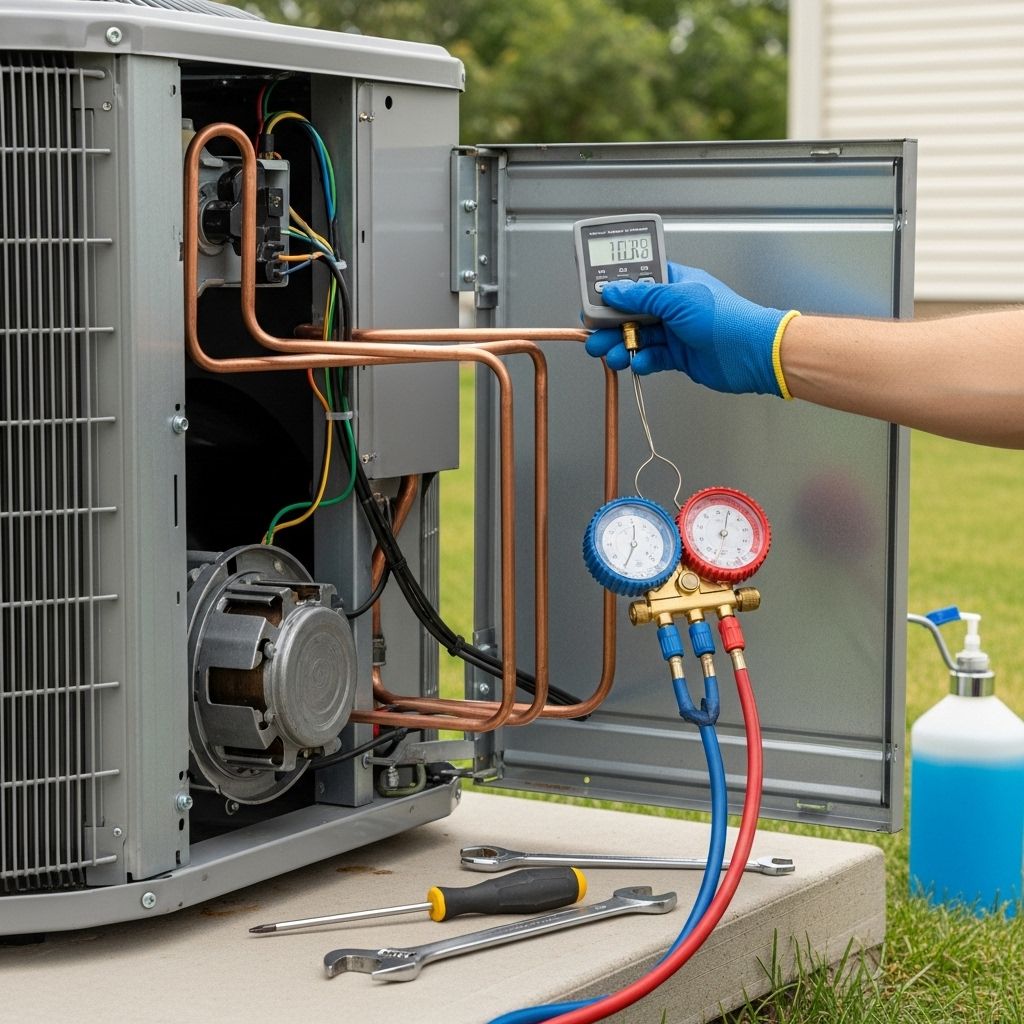AC Repair Cost: 9 Common Fixes And Typical Prices
Understanding what you'll pay for AC repairs and when it might be better to replace your system

Image: HearthJunction Design Team
Air Conditioner Repair Cost Overview
When your air conditioner stops working properly during hot weather, getting it fixed quickly becomes a top priority. Air conditioner repair costs can vary significantly depending on the specific issue, ranging from around $100 for minor fixes to over $1,500 for major component replacements. According to recent data, most homeowners pay between $150 and $650 for typical AC repairs, with an average cost of about $350.
Understanding what factors influence repair costs can help you make informed decisions about whether to repair or replace your system. In this comprehensive guide, we’ll break down the typical costs for common air conditioner repairs, discuss when repairs make financial sense versus replacement, and provide tips for maintaining your system to avoid costly breakdowns.
Factors Affecting Air Conditioner Repair Costs
Several key factors determine how much you’ll pay for air conditioner repairs:
Type of Air Conditioner
The type of air conditioning system you have significantly impacts repair costs. Central air conditioning systems typically cost more to repair than window units or portable air conditioners due to their complexity and the specialized knowledge required to work on them. Other system types like ductless mini-splits or heat pumps have their own unique components that may affect repair pricing.
Age and Condition of the Unit
Older air conditioners often require more extensive repairs and may have parts that are harder to find, increasing costs. Additionally, if your system has been poorly maintained over the years, repairs might be more extensive and therefore more expensive.
Warranty Coverage
If your air conditioner is still under warranty, you may only need to pay for labor costs while parts are covered by the manufacturer. Most AC warranties last between 5 and 10 years, though some premium models offer longer coverage. Always check your warranty status before proceeding with repairs.
Timing and Urgency
Emergency repairs during peak seasons (summer) or outside normal business hours typically cost more due to increased demand and overtime rates. Planning non-emergency repairs during the off-season can result in cost savings.
Local Market Rates
Labor costs vary significantly by location. Metropolitan areas generally have higher service rates than rural areas, though competition in larger markets can sometimes help moderate prices.
Common Air Conditioner Repairs and Their Costs
The specific component that needs repair or replacement is the most significant factor in determining your total cost. Here are the most common AC repairs and their typical price ranges:
| Type of Repair | Description | Typical Cost Range |
|---|---|---|
| Capacitor Replacement | Capacitors are essential for starting the compressor and fan motors | $150–$400 |
| Thermostat Repair/Replacement | Fixing electronic or wiring issues affecting temperature control | $100–$500 |
| Drain Line Cleaning | Unclogging condensate drain lines to prevent water damage | $80–$250 |
| Refrigerant Leak Repair | Finding and fixing leaks plus recharging refrigerant | $200–$1,500+ |
| Relay or Contactor Replacement | Replacing electrical components that control motors | $100–$450 |
| Evaporator or Condenser Coil Cleaning | Deep cleaning of coils to improve efficiency | $300–$600 |
| Fan Motor Replacement | Replacing failed motors in the indoor or outdoor unit | $250–$700 |
| Circuit Board Replacement | Replacing the main control board for the system | $200–$600 |
| Compressor Replacement | Replacing the system’s most crucial and expensive component | $800–$2,500 |
Capacitor Repair ($150–$400)
The capacitor is an electrical component that provides the extra power needed to start up your air conditioner’s motors. When a capacitor fails, your AC may struggle to turn on or stay running. Capacitor replacements are among the most common and affordable AC repairs, typically costing between $150 and $400 including parts and labor.
Thermostat Issues ($100–$500)
Thermostat problems can range from simple programming issues to complete failure. The cost to repair or replace a thermostat varies widely based on whether you opt for a basic model or a smart programmable thermostat. Basic thermostats might cost $100–$200 to replace, while advanced smart models can run $300–$500.
Drain Line Cleaning ($80–$250)
Air conditioners remove moisture from the air, which drains through a condensate line. When this line gets clogged with algae, mold, or debris, water can back up and cause leaks or trigger safety switches that shut down your system. Professional drain line cleaning typically costs between $80 and $250.
Refrigerant Leak Repair ($200–$1,500+)
Refrigerant leaks are serious problems that require prompt attention. The repair process involves finding the leak, repairing it, and then recharging the system with the proper amount of refrigerant. Costs vary widely depending on the location and severity of the leak, ranging from $200 for minor leaks to $1,500 or more for major ones.
Compressor Issues ($800–$2,500)
The compressor is the heart of your air conditioning system, and unfortunately, it’s also one of the most expensive components to repair or replace. When a compressor fails, you’re typically looking at $800 to $2,500 for replacement. In older systems, compressor failure often leads homeowners to consider full system replacement instead.
Labor Costs for AC Repairs
Labor makes up a significant portion of air conditioner repair costs. HVAC technicians typically charge between $75 and $150 per hour, with rates varying based on location, experience, and company policies. Many companies also charge a service call or diagnostic fee of $50 to $100, which may be waived if you proceed with the recommended repairs.
Most simple repairs require 1-2 hours of labor, while complex issues like compressor replacement might take 4-8 hours. Always ask for an estimate that breaks down parts versus labor costs before authorizing work.
DIY vs. Professional AC Repairs
While some minor maintenance tasks can be handled by homeowners, most air conditioner repairs should be left to licensed professionals. Here’s a breakdown of what you can safely do yourself versus what requires professional attention:
DIY-Friendly Tasks:
- Replacing air filters (every 1-3 months)
- Cleaning debris from around the outdoor unit
- Straightening bent fins on the outdoor unit
- Basic thermostat programming
- Checking circuit breakers if the unit won’t power on
Professional Tasks:
- Any repairs involving the refrigerant system
- Electrical component replacements
- Motor or compressor repairs
- Complex diagnostics when the cause isn’t obvious
- Annual professional maintenance tune-ups
Attempting complex repairs without proper training can void warranties, damage expensive components, or even create safety hazards. Additionally, working with refrigerants requires EPA certification, as these chemicals are regulated due to their environmental impact.
Repair vs. Replace: Making the Right Decision
When faced with significant repair costs, homeowners often wonder whether it’s better to repair the existing unit or invest in a replacement. Consider these guidelines when making your decision:
The 50% Rule
A common industry guideline suggests that if the repair cost exceeds 50% of the value of a new system, replacement is usually more economical in the long run. For example, if a new comparable system costs $6,000, you should consider replacement when facing repair bills over $3,000.
Age of the System
Air conditioners typically last 10-15 years. If your unit is approaching or exceeding this age range, even moderately expensive repairs may not be worth the investment. Newer systems offer improved energy efficiency that can offset replacement costs through lower utility bills.
Frequency of Repairs
If you’re calling for repairs multiple times per season or year after year, these cumulative costs often outweigh the price of a new, more reliable system. Frequent breakdowns also indicate that more components may fail soon.
Energy Efficiency Considerations
Older air conditioners typically have SEER (Seasonal Energy Efficiency Ratio) ratings of 10 or less, while new models must have a minimum SEER of 13-14 (depending on your region), with premium models reaching SEER 20+. This difference can translate to 20-40% energy savings with a new system.
Preventative Maintenance to Avoid Costly Repairs
Regular maintenance is the best way to prevent expensive air conditioner repairs and extend the lifespan of your system. Consider these preventative measures:
Annual Professional Tune-ups
Schedule professional maintenance every spring before the cooling season begins. A typical AC tune-up costs between $65 and $200 and includes comprehensive system checks, cleaning, and minor adjustments that can prevent major breakdowns.
Regular Filter Changes
Clean or replace air filters every 1-3 months depending on usage and filter type. Clogged filters restrict airflow, forcing your system to work harder and potentially causing component failures.
Keep the Outdoor Unit Clean
Regularly remove debris, leaves, and vegetation around the outdoor condenser unit, maintaining at least 2 feet of clearance for proper airflow.
HVAC Service Contracts
Many companies offer annual service agreements that include routine maintenance visits and priority service when repairs are needed. These typically cost $150-$300 per year but can save money through early problem detection and discounted repair rates.
Finding Reliable AC Repair Services
When you need air conditioner repairs, finding a qualified technician is crucial. Follow these tips to find reliable service:
- Verify proper licensing and insurance for your state
- Check online reviews and Better Business Bureau ratings
- Ask for recommendations from friends and neighbors
- Get multiple estimates for major repairs
- Confirm warranty policies on parts and labor
- Look for NATE-certified technicians (North American Technician Excellence)
Frequently Asked Questions (FAQs)
How often should air conditioners be serviced?
Most manufacturers and HVAC professionals recommend annual maintenance tune-ups, ideally in spring before the cooling season begins. Regular maintenance can prevent up to 85% of the repairs that air conditioners typically need.
Why is my air conditioner running but not cooling?
This common problem can have several causes, including refrigerant leaks, dirty filters, frozen evaporator coils, thermostat issues, or ductwork problems. A professional diagnosis is recommended to determine the specific cause.
Are AC repair costs covered by home warranties?
Many home warranties do cover air conditioner repairs, though coverage limits, deductibles, and exclusions vary by provider. Review your warranty terms carefully, as older systems or pre-existing conditions may not be covered.
How long does an air conditioner repair typically take?
Simple repairs like capacitor or thermostat replacements usually take 1-2 hours. More complex issues like refrigerant leaks or compressor problems might require 3-8 hours or multiple visits to complete.
Can I run my AC if it’s low on refrigerant?
Running an air conditioner that’s low on refrigerant can cause serious damage to the compressor, potentially leading to much more expensive repairs. If you suspect a refrigerant issue, it’s best to turn off the system until a professional can inspect it.
What’s the typical labor cost for AC repairs?
HVAC technicians typically charge between $75 and $150 per hour for labor, with rates varying by location, company, and the technician’s experience level. Emergency service or after-hours repairs often incur higher rates.
References
- https://www.thisoldhouse.com/heating-cooling/reviews/air-conditioner-repair-cost
- https://www.thisoldhouse.com/heating-cooling/reviews/ac-tune-up-cost
- https://www.homeserve.com/en-us/blog/cost-guide/ac-repair-costs/
- https://www.thisoldhouse.com
- https://www.homeadvisor.com/cost/heating-and-cooling/repair-an-hvac-system/
Read full bio of medha deb












